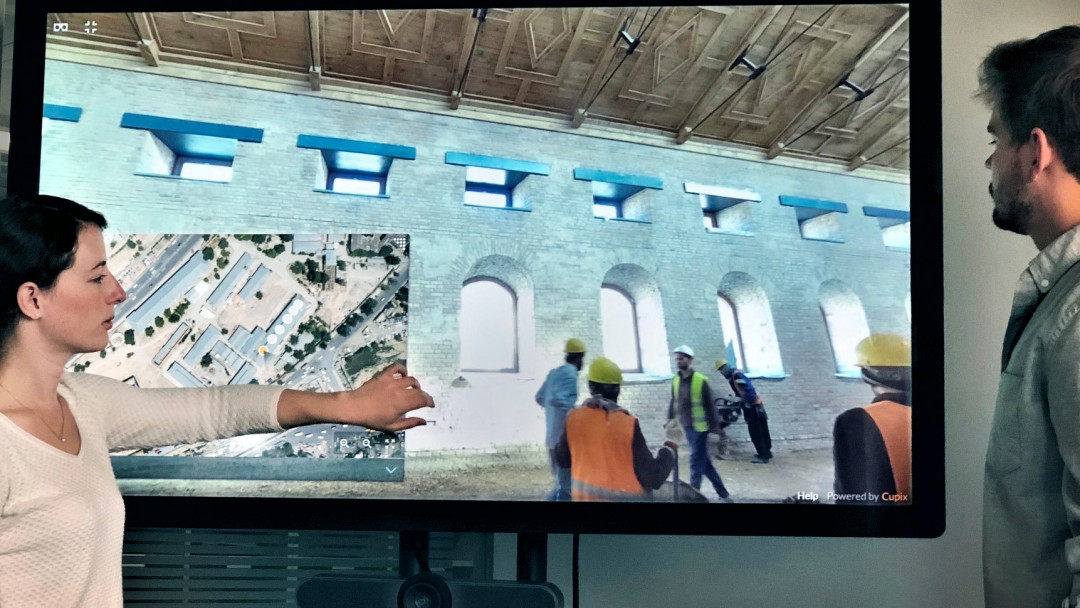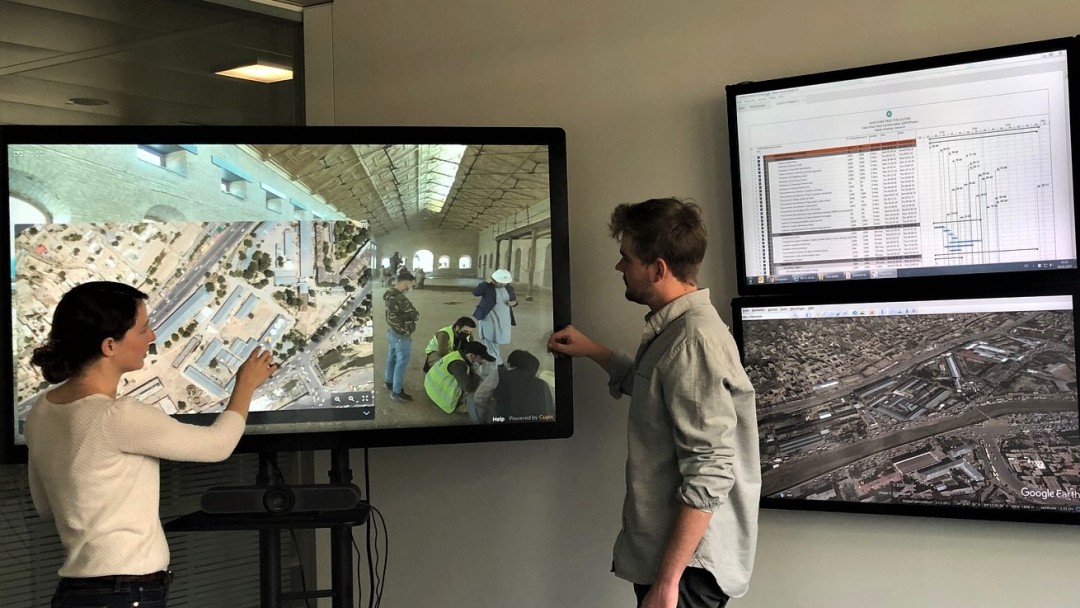
Zoom into Kabul, find the building, take a look inside, then inspect the construction progress – all this is possible with just a few taps on the screen, even at KfW. Namely in the RMMV lab, which has existed for a few months now. The separate room on the sixth floor of the Frankfurt Southern Arcade is equipped with various screens and cutting-edge hardware and software to further develop remote project management, known as “Remote Management, Monitoring and Verification” (RMMV).
The lab was initially set up as a test for the department responsible for Afghanistan, Pakistan und Iraq. The situation in Afghanistan in particular is so fragile that trips there can no longer take place or are only allowed in exceptional cases; the situation has been like this for four years already. At the same time, KfW supports the country at the Hindu Kush with an ongoing portfolio of around EUR 1.4 billion. To continue the projects and still keep operative risks as low as possible there was no other alternative: in addition to expanding the activities of local employees on site, different project monitoring methods became increasingly necessary, including remote monitoring methods based in Germany.

In the era of COVID-19, these experiences can benefit other development cooperation projects since they are also hampered by existing or recently introduced travel bans giving rise to the need for so-called “remote” solutions. Due to its experience with fragile states, KfW has gained several general insights about the resulting opportunities and aspects that need to be taken into account:
1. It is always worth considering RMMV: RMMV is an instrument that is well-suited as a – smaller or larger – component for many projects. So it is always worth making an effort to assess whether “remote management elements” can be built into a project. There is no need to immediately create comprehensive projects that solely rely on it, but it is an aspect that should be taken into account during project planning.
2. This is about more than technology: people often equate RMMV approaches with technical solutions like satellite images, drones and other digitally supported tools. However in reality, it is important to differentiate between personnel-driven and technology-driven approaches. For example, the first approach concerns personnel on site, either local KfW employees or consultants who continue to have access to the project region or are able to gain access. A combination of both is usually recommended as management and supervision using digital resources alone cannot provide all necessary information. “We can't smell things; we can't taste things. We can't dig out a pillar to see if it is really as deep in the ground as planned,” Portfolio Manager Dr Anja Hanisch from the Governance and Peace team explains the benefit.
3. Particularly suitable for fragile states and for large project areas: RMMV is especially interesting in fragile contexts if countries and target areas cannot be visited. Or if projects cover a large area, like decentralisation or biodiversity projects such as afforestation. Satellite images can be useful in these cases. “So far, the benefits of RMMV cannot be determined according to sector. It has much more to do with specific project design,” says Portfolio Manager Maja Bott, who, like Hanisch, has already gained a good deal of experience with RMMV.
4. A lot of preparation, higher initial costs: RMMV initially requires much time and effort on the part of portfolio managers. The specific needs must be defined, the technology must be set up or maybe even procured. Other project documents, possibly other consultants are needed, and everything must be evaluated and assessed at the end. However, once the process is set up, RMMV is able to simplify work in the long run and possibly also reduce costs. But frequently it is not about time, effort and costs, but about making it possible to carry out projects at all because they would not otherwise be possible, for example in the conflict-ridden areas in Northern Mali – or in coronavirus risk areas.
5. Data security on site is paramount: a lot of data is collected when technologies are used. So it is always important to examine what is permitted in the relevant country. Is it possible to use drones? Can we evaluate satellite images? If yes, under what conditions? Otherwise the greatest technology is useless or information is incorrect. Privacy is also important, as KfW does not want to endanger anyone with its projects. These types of considerations need to be made beforehand and are critical to the success of each RMMV approach.
These are the most important conclusions from a long list that the Governance and Peace team collected and compiled into a manual of the same name. The manual describes various RMMV approaches, their methods and tools. Originally intended as a guide for Portfolio Managers who need to operate in conflict-ridden environments, it came at just the right time for the coronavirus crisis. “The manual is a living document,” says responsible Team Head Michael Gruber, “because we are constantly learning, both about the technology and the possible applications. And it will remain this way beyond the pandemic. Development cooperation is currently rapidly changing.”
Share page
To share the content of this page with your network, click on one of the icons below.
Note on data protection: When you share content, your personal data is transferred to the selected network.
Data protection
Alternatively, you can also copy the short link: https://www.kfw-entwicklungsbank.de/s/enzBXtdc
Copy link Link copied